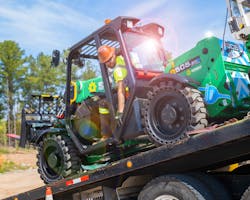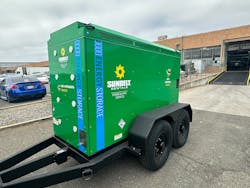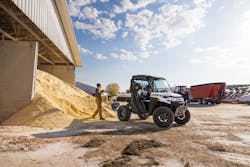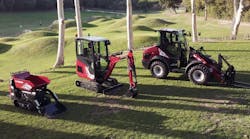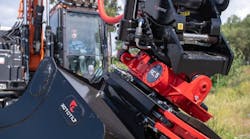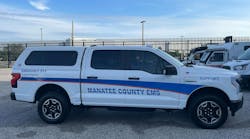Just as adoption of telematics was slow at first, so too is the move to electric and hybrid equipment.
To be fair, many managers thinking of going green are waiting for smaller, lighter battery solutions for heavier equipment, or the proliferation of non-battery solutions through alternate fuels such as hydrogen and clean diesel.
Some hold their breath about acquisition costs and eventual battery replacement costs.
Still others are skeptical about battery performance in cold weather, and the amount and availability of power sources--perhaps the quality of the grid where they must work, or how hydrogen would reach their job sites.
Finally, there are those managers who have equipment working 24 hours a day and worry how charging and battery replacement would alter their operations.
Read also: Renewable diesel holds promise for fleet sustainability
One way to measure an appetite for electric equipment is through rental. Rental is also the destination for specialized, short-term fleet needs, such as for indoor work, and urban areas under strict noise or emissions rules, as well as for portable power solutions.
Two rental heavyweights, United Rentals and Sunbelt Rentals, have eagerly jumped into the electric/hybrid arena--and the world of battery-driven or hydrogen-driven portable power--and they’re slowly finding takers.
United Rentals' national fleet is 31 percent electric or hybrid (that total is for motorized equipment and does not include non-motorized pieces or hand tools). It includes compact machines from Takeuchi and JCB, and a partnership with Powrbank on battery systems.
The Powerbank portable energy storage system integrates with diesel generators. The aim is to reduce generator runtime and emissions, as well as noise and fuel use.
The model designed specifically for United Rentals is rated for 40kW to 60kW of power output and provides between 60kW and 120kW hours of storage through high-density lithium batteries, inverters, and load-sensing technology. When the batteries are run down,
“As an industry leader, we’re using our position to support sustainable changes on construction and industrial job sites,” says Grant Zoldowski, director, environmental management. “Part of this effort involves growing our fleet of alternatively fueled equipment and offering proprietary emissions estimation tool, all with the goal of minimizing the impact on the planet and building a better, more sustainable future.”
United has also made a start on hydrogen, giving its customers access to EODev's GEH2 hydrogen generated provided by Generac. It provides up to 100kVA for power to any site, the company says, including off-grid locations or areas with strict emissions regulations. It also has 4G connectivity so users can check operating status on their devices.
At first, Sunbelt Rentals jumped into electric through aerial and material handling equipment. "In recent years, we’ve expanded more into the earthmoving equipment as well as smaller equipment such as solar lighting, compaction and concrete products," says Brent Coffey, director, product line management at Sunbelt Rentals. "Sunbelt’s electric fleet is already extensive and growing, but our offering continues to expand in non-traditional product segments as OEMs are constantly challenged to reduce emissions, and these hybrid solutions are the way to address that challenge. Not only that, but a lot of our customer base are driving it–especially general contractors."
The company did not divulge the exact percentage of its national fleet that is electric or hybrid.
Read also: Sustainability is more than a buzzword
"A large portion of Sunbelt’s electric fleet lives in material handling equipment, but we see significant growth in other categories like power solutions, lighting solutions, earthmoving, and general construction equipment," Coffey says.
In characterizing what kinds of contractors are using electric/hybrid equipment, Coffey says it is indeed companies relying on the rental industry for their initial introduction to the technology.
"The idea of 'try before you buy,' or perhaps they only want to explore this option for a specific application, has been very successful in changing perceptions and providing that first-hand experience," he says. "The awareness of electric/hybrid equipment continues to grow as we’re able to walk customers through, not just how to use the equipment, but also the benefits, applications, the power and charging solutions--we’re able to be a true resource for them as they explore."
Coffey says Sunbelt has seen growth in electric/hybrid equipment in applications where products typically idle a lot, such as telehandlers. "Battery-powered versions do not use energy unless the machine is actually moving, so they are prime candidates for non-ICE [internal combustion engine] power. Other examples of needing electrified equipment could be for improving job site safety, and reducing noise and reducing fuel emissions, especially when working indoors. There are a lot of utilization options for this type of equipment," according to Coffey.
Electric energy storage
A cornerstone of Sunbelt's battery strategy is offering a battery energy storage system, or BESS. A battery energy storage system is a multicomponent system able to store varying amounts of energy and use it later for a multitude of purposes, including supplementing generator or grid power.
When needed, batteries discharge and release the stored energy. Here’s how it works:
- When the grid or generator is supplying power to the site, excess power is used to recharge the batteries.
- The BESS inverter converts the stored DC energy into AC energy. When the BESS is disconnected from the grid or the generator is switched OFF, the energy load is supplied by the BESS. The changeover is seamless, and the hybrid quietly provides power.
- The generator restarts when batteries are depleted or when the energy load exceeds what the unit can support.
BESSs are designed to maximize both kilowatts and kilowatt hours . If the system is used to reduce utility charges during peak hours, the system can efficiently charge many times over short durations of time. If needed for backup power, it is designed to discharge over a longer period. BESSs are rated for power capacity (measured in kW) and energy capacity (measured in kWh).
Sunbelt says a BESS can reduce diesel fuel consumption and cost typically by 40% to 60%–topping out as much as 95%–depending on the application.
United Rentals also offers BESS systems.
“Hybrid power solutions can help companies by supplying the power they need for productivity and safety in a way that lowers operations costs and emissions,” said Dan Gribbell, PHVAC region sales and marketing director for United Rentals. “United Rentals can help companies leverage a hybrid power solution that addresses their specific power requirements, including hydrogen or propane generators used with a BESS or on their own, so their businesses stay agile and responsive.”
In a recent project, a large construction customer reduced cost by 34% and reduced generator runtime by two-thirds, United says.
United Rentals has gone electric beyond the traditional mini-excavators and Ford F-150 Lightning pickup trucks, with the addition of all-electric Polaris Ranger XP Kinetic utility vehicles.
“Polaris and United Rentals customers are very demanding of their utility vehicles–all our UTV customers expect the best from Polaris as the world leader in powersports and off-road innovation,” says Jamie Juliano, director of commercial sales, North America, Polaris. “Ranger XP Kinetic establishes a new standard for UTV performance and productivity, delivering uncompromised capability, unrivaled durability and refined performance in an all-electric, sustainable platform.”
“There used to be a concern around electric vehicles that they were less capable than their combustion engine counterparts, and that’s just not the case anymore, says TJ Mahoney, VP, supply chain, United Rentals. "Electric vehicles provide a lot of benefits on the job site and it’s important that United Rentals’ customers have access to them, without sacrificing the task at hand,” said “Adding Polaris Ranger XP Kinetic UTVs bolsters our UTV fleet while supporting our, and our customers’ sustainability initiatives and electrification strategy.”
The XP Kinetic's has an advanced drivetrain that features fewer moving parts, and delivers 110 horsepower and 140 lb.-ft. of instant torque. It tows 2,500 pounds and hauls 1,250 pounds. Fourteen inches of ground allows it to rise over obstacles, and it is equipped with 29-inch, 8-ply Pro Armor X-Terrain tires for added traction and durability. And with 10-inches of suspension travel, XP Kinetic smooths out the bumps so customers can ride comfortably in challenging terrain – no matter where the job takes them.
The Ranger XP Kinetic is available as a 3-seat model and offered in Premium and Ultimate trims. The Premium trim is equipped with 14.9 kWh of lithium-ion battery capacity and offers an estimated range of up to 45 miles, while the Ultimate trim has 29.8 kWh of battery capacity and offers an estimated range of up to 80 miles, depending on the application and conditions.
In addition to high and low gear, RANGER XP Kinetic also has three drive modes for maximum versatility optimized to driving conditions and range management:
- Eco+: Optimizes torque and top speed for maximum range and light duty jobs
- Standard: Optimizes throttle response for everyday driving and moderate-sized jobs
- Sport: Optimizes throttle response for spirited driving and the tough jobs.
Polaris Commercial works with United Rentals to provide gas and diesel Pro XD UTVs, gas and now electric-powered Rangers to locations across the U.S. A partner since 2015, Polaris Commercial was recognized by United Rentals as a Top Supplier for 2021.
Partnerships with OEMs have been critical to rental's green efforts.
Early in Sunbelt's electric journey, it partnered with MEWP manufacturer JLG to test lithium-ion batteries in cold temperatures. JLG's all-electric Da Vinci scissor lift was the subject of the test.
Electrics in cold weather
Despite the concerns associated with electric machinery, electric options are often needed on construction or maintenance projects in cold conditions due to noise and air pollution requirements that prevent the use of internal-combustion machines. Battery-powered scissor lifts have been around a long time but were typically limited to only having enough power to electrify components such as the drive system. The rest of the machines’ systems, such as the lift and steer functions, run on hydraulics.
A common battery technology used to power MEWPs is FLA. These batteries are designed for peak performance and life, are relatively easy to maintain, and can work in a vast temperature range while being durable and forgiving of misuse. But flooded lead acid batteries pose their fair share of issues beyond machine sluggishness and runtime degradation.
For example, they should ideally retain a minimum of 80% charge otherwise the batteries will self-deteriorate, ultimately affecting capacity. Additionally, if an FLA battery is deeply discharged and the environment’s temperature is low enough, the battery will freeze into an ice cube, impacting the battery’s service life.
None of these issues exist with the DaVinci all-electric scissor lift because it’s powered with lithium-ion batteries instead of flooded lead acid batteries. These advanced batteries experience zero performance degradation even as the battery is depleted, allowing teams to work more productively. To further enhance efficiency, the DaVinci lift takes 3.5 hours to fully charge and can be topped off periodically throughout the day without damaging the battery. There is also no concern of acid leaks or outgassing.
Lithium-ion technology isn’t unique to the JLG DaVinci lift, but there are a few features that make the 19-foot all-electric MEWP stand out. Models from other OEM brands require multiple batteries to run the equipment, while the DaVinci lift uses just one. This is possible because the engineers worked to optimize energy consumption across the board, resulting in single-battery operation without compromising performance.
Another factor that makes the DaVinci scissor lift stand out is its battery management, especially in below-zero applications. In extremely cold temperatures, FLA batteries experience bigger voltage drops resulting in the machine’s control system thinking the batteries are nearly out of charge. The equipment will then limit performance to preserve basic functionality. This doesn’t happen with fully electrified machines because the power needed to run them is cut by more than 40%. Plus, lithium-ion batteries can work consistently at 32 F or below without needing to maintain a high state of charge.
The DaVinci lift also features an advanced battery management system (ABMS) that monitors charge and usage while also providing detailed diagnostic fi information about the battery via the DaVinciGo app. All of this means nothing if the scissor lift doesn’t perform in real-life applications.
The team chose one of the harshest test environments they could find—and industrial freezer located in Concord, North Carolina. The unit was 40 feet wide by almost 150 feet long with ceilings near 28 feet high and was split into two rooms. The first, smaller room was a receiving area where pallets of material were loaded and unloaded from tractor-trailers. This room’s temperature was 20 F, according to a gauge near the entrance of the freezer.
The second room was a long-term storage room with floor-to-ceiling racks to store goods. The temperature there was 0 F.
Austin Caskey, product line manager at Sunbelt Rentals, noted the customer would often use scissor lifts to complete cleaning and maintenance tasks in both freezer areas.
To start the test, the team placed the DaVinci lift in the warmest part of the freezer with a 97% state of charge and stored it overnight to simulate equipment being stored outside in the norther U.S. and Canada. When checked in the morning, the battery’s charge was degraded by less than 10 percent with an internal temperature of 12 F. The team plugged the battery into the charger for 45 minutes, increasing the internal temperature to 27 F.
Once the machine was warmed up and fully charged, Sunbelt Rentals and JLG started a series of duty-cycle tests, which include drive, elevate, descend, and return cycles, while data was collected by the DaVinciGo app. Caskey says typically Sunbelt Rentals would rent two scissor lifts in freezer applications because common performance loss issues with hydraulic machines in cold temperatures. In approximately two hours, the all-electric lift showed no signs of performance degradation. “We went up and down a lot with the machine during the test—doing way more than a normal work cycle and there was no degradation in performance,” says Caskey.
During a 45-minute break, the team parked the DaVinci lift in the coldest part of the freezer, while battery data continued to be collected. When testing resumed, the team was able to complete additional cycles, even after being stored at almost 0 F. As the machine started to slow on its own, it completed one final cycle—a different outcome than what the team would get with a traditional electric drive model. The lift was able to complete 26 total cycles.
“The 19-foot scissor lift is one of the most commoditized rental machines in the world. But, this one is unlike anything else available in the market, and our customers are taking note. It charges faster and stays charged longer, and the difference is notable,” says Caskey.
Sunbelt Rentals now carries a large fleet of JLG DaVinci scissor lifts with plans to add additional units as demand increases.
"The trend we're seeing in electrified equipment... within the commercial construction industry is only going to get bigger," says Coffey.
